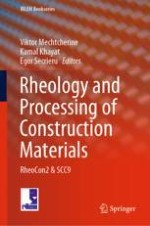
2020 | OriginalPaper | Chapter
Influence of Waste Tire Rubber on Fresh and Hardened Properties of Self-Compacting Rubberized Concrete (SCRC)
Authors : Robert Bušić, Ivana Miličević
Published in: Rheology and Processing of Construction Materials
Publisher: Springer International Publishing
Activate our intelligent search to find suitable subject content or patents.
Select sections of text to find matching patents with Artificial Intelligence. powered by
Select sections of text to find additional relevant content using AI-assisted search. powered by